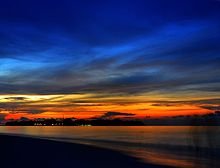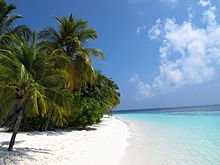Maldives best places for tourist so please visit once in life and enjoy these beautiful places , i think u really enjoyed it..
The Maldives archipelago is located atop the Chagos-Maldives-Laccadive Ridge, a vast submarine mountain range in the Indian Ocean, which also forms a terrestrial ecoregion, together with the Chagos and the Lakshadweep.[14] With an average ground-level elevation of 1.5 metres (4 ft 11 in) above sea level,[15] it is the world's lowest country, with even its highest natural point being the lowest in the world, at 2.4 metres (7 ft 10 in).[15] Due to the consequent risks posed by rising sea-levels, the government pledged in 2009 to make the Maldives a carbon-neutral country by 2019.[16][needs update]
The Maldivian archipelago took to Islam in the 12th century and consolidated as a sultanate, developing strong commercial and cultural ties with Asia and Africa. From the mid 16th-century, the region came under the increasing influence of European colonial powers, with the Maldives becoming a British protectorate in 1887. Independence from the United Kingdom was achieved in 1965 and a presidential republic was established in 1968 with an elected People's Majlis. The ensuing decades have been characterised by political instability, efforts at democratic reform,[17] and environmental challenges posed by climate change.[citation needed]
The Maldives is a founding member of the South Asian Association for Regional Cooperation (SAARC). It is also a member of the United Nations, the Organization of Islamic Cooperation, and the Non Aligned Movement. The World Bank classifies the Maldives as having an upper middle income economy.[18] Fishing has historically been the dominant economic activity, and remains the largest sector by far, followed by the rapidly growing tourism industry. Along with Sri Lanka, it is one of only two South Asian countries rated "high" on the Human Development Index,[12] with its per capita income one of the highest among SAARC nations.[19]
The Maldives was a Commonwealth republic from July 1982 until its withdrawal from the Commonwealth in October 2016 in protest of international criticism of its records in relation to corruption and human rights.
The Maldives consists of 1,192 coral islands grouped in a double chain of 26 atolls, along the north-south direction, spread over roughly 90,000 square kilometres (35,000 sq mi), making this one of the world's most dispersed countries. It lies between latitudes 1°S and 8°N, and longitudes 72° and 74°E. The atolls are composed of live coral reefs and sand bars, situated atop a submarine ridge 960 kilometres (600 mi) long that rises abruptly from the depths of the Indian Ocean and runs north to south.
Only near the southern end of this natural coral barricade do two open passages permit safe ship navigation from one side of the Indian Ocean to the other through the territorial waters of Maldives. For administrative purposes the Maldivian government organised these atolls into twenty one administrative divisions. The largest island of Maldives is Gan, which belongs to Laamu Atoll or Hahdhummathi Maldives. In Addu Atoll the westernmost islands are connected by roads over the reef (collectively called Link Road) and the total length of the road is 14 km (9 mi).
Maldives is the lowest country in the world, with maximum and average natural ground levels of only 2.4 metres (7 ft 10 in) and 1.5 metres (4 ft 11 in) above sea level, respectively. In areas where construction exists, however, this has been increased to several metres. More than 80 per cent of the country's land is composed of coral islands which rise less than one metre above sea level.[55] As a result, the Maldives are at high risk of being submerged due to rising sea levels. The UN's environmental panel has warned that, at current rates, sea level rise would be high enough to make the Maldives uninhabitable by 2100.[56][57]
Protected areas of Maldives Edit
Protected areas of Maldives are administrated by Ministry of Environment and Energy and Environmental Protection Agency (EPA) of Maldives. There are 31 protected areas in Maldives.[58]
Climate Edit

Sunset in the Maldives
The Maldives has a tropical monsoon climate (Am) under the Köppen climate classification, which is affected by the large landmass of South Asia to the north. The presence of this landmass causes differential heating of land and water. These factors set off a rush of moisture-rich air from the Indian Ocean over South Asia, resulting in the southwest monsoon. Two seasons dominate Maldives' weather: the dry season associated with the winter northeastern monsoon and the rainy season which brings strong winds and storms.
The shift from the dry northeast monsoon to the moist southwest monsoon occurs during April and May. During this period, the southwest winds contribute to the formation of the southwest monsoon, which reaches Maldives in the beginning of June and lasts until the end of August. However, the weather patterns of Maldives do not always conform to the monsoon patterns of South Asia. The annual rainfall averages 254 centimetres (100 in) in the north and 381 centimetres (150 in) in the south.[59]
The monsoonal influence is greater in the north of the Maldives than in the south, more influenced by the equatorial currents.
Climate data for Malé (1981–2010)
Month Jan Feb Mar Apr May Jun Jul Aug Sep Oct Nov Dec Year
Average high °C (°F) 30.3
(86.5) 30.7
(87.3) 31.4
(88.5) 31.6
(88.9) 31.2
(88.2) 30.6
(87.1) 30.5
(86.9) 30.4
(86.7) 30.2
(86.4) 30.2
(86.4) 30.1
(86.2) 30.1
(86.2) 30.61
(87.11)
Daily mean °C (°F) 28.0
(82.4) 28.3
(82.9) 28.9
(84) 29.2
(84.6) 28.8
(83.8) 28.3
(82.9) 28.2
(82.8) 28.0
(82.4) 27.8
(82) 27.8
(82) 27.7
(81.9) 27.8
(82) 28.2
(82.8)
Average low °C (°F) 25.7
(78.3) 25.9
(78.6) 26.4
(79.5) 26.8
(80.2) 26.3
(79.3) 26.0
(78.8) 25.8
(78.4) 25.5
(77.9) 25.3
(77.5) 25.4
(77.7) 25.2
(77.4) 25.4
(77.7) 25.8
(78.4)
Average rainfall mm (inches) 114.2
(4.496) 38.1
(1.5) 73.9
(2.909) 122.5
(4.823) 218.9
(8.618) 167.3
(6.587) 149.9
(5.902) 175.5
(6.909) 199.0
(7.835) 194.2
(7.646) 231.1
(9.098) 216.8
(8.535) 1,901.4
(74.858)
Average precipitation days (≥ 1.0 mm) 6 3 5 9 15 13 12 13 15 15 13 12 131
Average relative humidity (%) 78.0 77.0 76.9 78.1 80.8 80.7 79.1 80.5 81.0 81.7 82.2 80.9 79.7
Mean monthly sunshine hours 248.4 257.8 279.6 246.8 223.2 202.3 226.6 211.5 200.4 234.8 226.1 220.7 2,778.2
Source #1: World Meteorological Organization[60]
Source #2: NOAA (relative humidity and sun 1961–1990)[61]
See also: The Island President

The white sandy beaches of Maldives
The Intergovernmental Panel on Climate Change's 2007 report predicted the upper limit of the sea level rises will be 59 centimetres (23 in) by 2100, which means that most of the republic's 200 inhabited islands may need to be abandoned.[62] One study appears to show that the sea level in the Maldives dropped 20–30 centimetres (8–12 in) throughout the 1970s and '80s, although later studies failed to back this up.[63] The observed rate of sea level rise is only 1.7–1.8 millimetres per year.[64]
According to former Maldivian president Mohamed Nasheed, the Maldives are ranked the third most endangered nation due to flooding from climate change.[65] In March and April 2012, Nasheed stated, "If carbon emissions were to stop today, the planet would not see a difference for 60 to 70 years." "If carbon emissions continue at the rate they are climbing today, my country will be under water in seven years." He called for more climate change mitigation action while on the American television shows The Daily Show[66] and the Late Show with David Letterman.[67] This opinion was disputed in 2012, when the next President said: "The good news is that Maldives is not about to disappear....on the basis of technical and scientific information that we have, that we will be able to manage climate change in the Maldives and prolong the life for the islands and for our life on these islands."[68]
In November 2008, President Mohamed Nasheed announced plans to look into purchasing new land in India, Sri Lanka, and Australia because of his concerns about global warming, and the possibility of much of the islands being inundated with water from rising sea levels. The purchase of land will be made from a fund generated by tourism.[69] The President has explained his intentions: "We do not want to leave the Maldives, but we also do not want to be climate refugees living in tents for decades".[70] On 22 April 2008, then President Maumoon Abdul Gayoom pleaded for a cut in global greenhouse gas emissions, warning that rising sea levels could submerge the island nation of Maldives.[71][72]
By 2020, Maldives plans to eliminate or offset all of its greenhouse gas emissions. At the 2009 International Climate Talks, President Mohamed Nasheed explained that:
For us swearing off fossil fuels is not only the right thing to do, it is in our economic self-interest... Pioneering countries will free themselves from the unpredictable price of foreign oil; they will capitalise on the new green economy of the future, and they will enhance their moral standing giving them greater political influence on the world stage.[73]
Other environmental issues include bad waste disposal and beach theft. Although the Maldives are kept relatively pristine and little litter can be found on the islands, no good waste disposal sites exist. Most trash from Male and other resorts is simply dumped at Thilafushi

I hope I paint sunset at Maldives someday!!!
Thanks for the post
Congratulations @salmanalishah! You received a personal award!
Click here to view your Board
Congratulations @salmanalishah! You received a personal award!
You can view your badges on your Steem Board and compare to others on the Steem Ranking
Vote for @Steemitboard as a witness to get one more award and increased upvotes!